The use of a beer can inserted into a chicken is an old barbeque trick to provide flavored steam to the inside of the chicken as it cooks. At the same time, the beer supposely adds flavor to the chicken. Problem is, I don't quite buy it. If the beer is giving off steam, then most of that steam is just going to be water... most of the beer flavor will just be concentrating in the can. However, it seems that it would be sacrilegeous if I used the beer can but left out the beer.
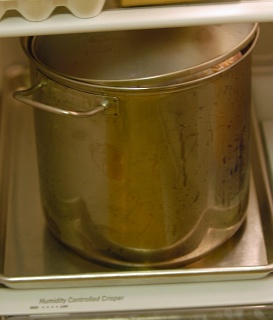 The first step is to brine the turkey. Find a non-reactive (polycarbonate plastic, glass, or stainless steel) container large enough to hold the turkey. Prepare a brining solution of 1 cup table salt to 1 gallon water and soak the turkey in the solution in the refrigerator for four to six hours. (If your turkey has been infused with a solution, then reduce the salt content in your brine or just soak it in a container filled with plain water.)
The first step is to brine the turkey. Find a non-reactive (polycarbonate plastic, glass, or stainless steel) container large enough to hold the turkey. Prepare a brining solution of 1 cup table salt to 1 gallon water and soak the turkey in the solution in the refrigerator for four to six hours. (If your turkey has been infused with a solution, then reduce the salt content in your brine or just soak it in a container filled with plain water.)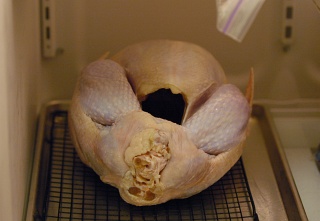 Pour out the brining solution and rinse the turkey. One convenient way to do this is to position a rack in the sink and place the turkey on the rack to rinse. After the turkey has been rinsed, let it dry by placing it on a rack on a sheet pan in the refrigerator overnight (or for eight hours). Alternatively, use a blow drier on cool setting (no heat) to blow over the skin of the turkey until dry.
Pour out the brining solution and rinse the turkey. One convenient way to do this is to position a rack in the sink and place the turkey on the rack to rinse. After the turkey has been rinsed, let it dry by placing it on a rack on a sheet pan in the refrigerator overnight (or for eight hours). Alternatively, use a blow drier on cool setting (no heat) to blow over the skin of the turkey until dry.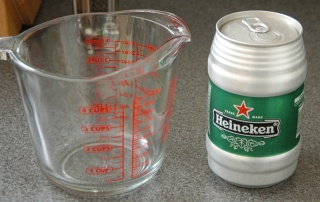 In order to prepare beer can turkey, a beer can is necessary. However, a normal 12-oz. beer can, perfect for a chicken, is a bit too small for the large cavity of a turkey. At my local convenience store, I found this 24 oz. micro-keg shaped can of Heineken. It looked to be about the right size, so I bought it.
In order to prepare beer can turkey, a beer can is necessary. However, a normal 12-oz. beer can, perfect for a chicken, is a bit too small for the large cavity of a turkey. At my local convenience store, I found this 24 oz. micro-keg shaped can of Heineken. It looked to be about the right size, so I bought it.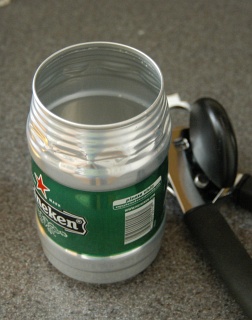 After pouring the beer into another container (a large measuring cup), remove the top of the can. I used an OXO Good Grips can opener to cleanly remove the top (it took only one pass). Removing the top provides enough surface area from which the steam can rise. The small opening made by the pop top just isn't enough of an opening to effectively provide moisture to the turkey.
After pouring the beer into another container (a large measuring cup), remove the top of the can. I used an OXO Good Grips can opener to cleanly remove the top (it took only one pass). Removing the top provides enough surface area from which the steam can rise. The small opening made by the pop top just isn't enough of an opening to effectively provide moisture to the turkey.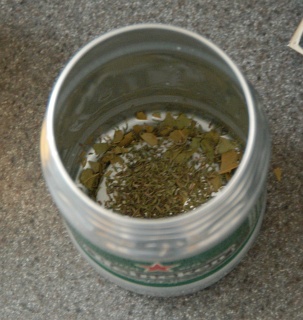 Deposit six bay leaves (broken up) and two teaspoons dried thyme into the can. Unlike the beer, the herbs will provide noticeable flavor and aroma while the steam helps keep the turkey moist during it's long cooking process.
Deposit six bay leaves (broken up) and two teaspoons dried thyme into the can. Unlike the beer, the herbs will provide noticeable flavor and aroma while the steam helps keep the turkey moist during it's long cooking process.Related Articles
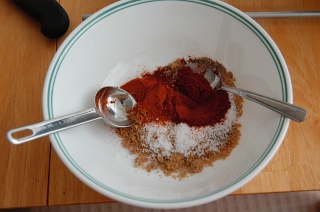 Prepare a spice rub by combining two tablespoons brown sugar, two tablespoons paprika, one tablespoon kosher salt, one tablespoon black pepper, and one teaspoon cayenne pepper. Mix the spice rub well.
Prepare a spice rub by combining two tablespoons brown sugar, two tablespoons paprika, one tablespoon kosher salt, one tablespoon black pepper, and one teaspoon cayenne pepper. Mix the spice rub well.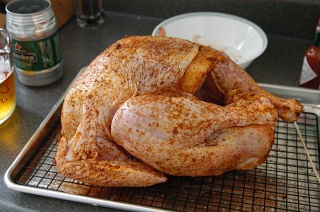 Rub the spice rub over the entire exterior of the turkey. Loosen the skin over the breasts and thighs and rub the spices under the skin. Finally, rub the remaining spice rub inside the cavity of the turkey.
Rub the spice rub over the entire exterior of the turkey. Loosen the skin over the breasts and thighs and rub the spices under the skin. Finally, rub the remaining spice rub inside the cavity of the turkey.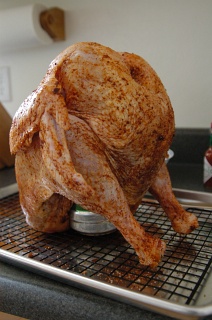 Pour half the beer back into the open beer can (reserving half for your drinking pleasure). Not pouring all the beer back reduces the risk of spilling as you transport the turkey to and from the grill. Lift the turkey up and lower it onto the beer can.
Pour half the beer back into the open beer can (reserving half for your drinking pleasure). Not pouring all the beer back reduces the risk of spilling as you transport the turkey to and from the grill. Lift the turkey up and lower it onto the beer can.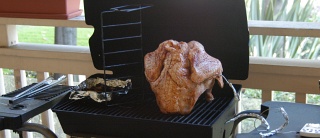 Place the turkey on the grill. If using a gas grill, position the turkey over one burner, away from the other burners. Turn the burner under the turkey off and turn the other burners on low. If using a charcoal grill, start the charcoals (you'll need a couple batches of about 100 briquettes each over the course of the smoking). When they're ready, push them to the outer edges of the grill leaving the center available for the turkey. Make a container with aluminum foil (or use a metal wood chip tray) and fill it with the wood chips that were soaking in water. Place the container over the other burner or on the hot coals. My grill was not large enough to cover the turkey without the lid touching it, so I placed a V rack in the middle to prop up the lid. I also inserted a Polder Cooking Thermometer into a thigh to track the temperature of the turkey.
Place the turkey on the grill. If using a gas grill, position the turkey over one burner, away from the other burners. Turn the burner under the turkey off and turn the other burners on low. If using a charcoal grill, start the charcoals (you'll need a couple batches of about 100 briquettes each over the course of the smoking). When they're ready, push them to the outer edges of the grill leaving the center available for the turkey. Make a container with aluminum foil (or use a metal wood chip tray) and fill it with the wood chips that were soaking in water. Place the container over the other burner or on the hot coals. My grill was not large enough to cover the turkey without the lid touching it, so I placed a V rack in the middle to prop up the lid. I also inserted a Polder Cooking Thermometer into a thigh to track the temperature of the turkey.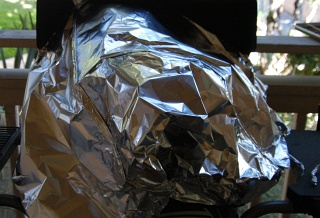 Close the lid of the grill. If the turkey is too tall for your grill lid, find a way to prop open the lid just enough (so the lid is mostly closed, but not touching the bird). Then use heavy duty aluminum foil to cover the gap that's left. The aluminum foil lets out a lot of heat, but will help keep the smoke in long enough to flavor the turkey.
Close the lid of the grill. If the turkey is too tall for your grill lid, find a way to prop open the lid just enough (so the lid is mostly closed, but not touching the bird). Then use heavy duty aluminum foil to cover the gap that's left. The aluminum foil lets out a lot of heat, but will help keep the smoke in long enough to flavor the turkey.The actual cooking of the turkey is a bit finicky and has a lot to do with your grill and how much cooling air is getting into the grill from the slightly open lid. If you didn't need to prop open the lid of your gas grill, keep the burners on low. However, if you did need to prop open the lid, you might need to turn up the heat to compensate for the heat loss? Don't turn on the burner underneath the turkey - we want to cook it with indirect heat. If using charcoal, after the first one and a half to two hours, you'll need to start a new batch of charcoal and replace the original coals as they lose heat.
Halfway through the cooking, about two hours, rotate the turkey to allow even cooking.
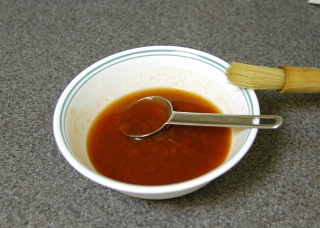 When the thigh meat reaches 160°F (71°C) (about 4-1/2 hours in my example), prepare a simple glaze with two tablespoons brown sugar, two tablespoons ketchup, two tablespoons distilled white vinegar, two tablespoons beer, and two teaspoons of hot sauce (I prefer Frank's RedHot Original Hot Sauce). Brush the glaze onto the turkey and cover. After five minutes, brush on another layer of glaze and allow it to cook until the thigh meat registers 170°F (77°C). If you don't have a thermometer, at least poke the turkey with a skewer to see if the juices run clear. If the fluid that comes out contains traces of blood, continue to cook the turkey.
When the thigh meat reaches 160°F (71°C) (about 4-1/2 hours in my example), prepare a simple glaze with two tablespoons brown sugar, two tablespoons ketchup, two tablespoons distilled white vinegar, two tablespoons beer, and two teaspoons of hot sauce (I prefer Frank's RedHot Original Hot Sauce). Brush the glaze onto the turkey and cover. After five minutes, brush on another layer of glaze and allow it to cook until the thigh meat registers 170°F (77°C). If you don't have a thermometer, at least poke the turkey with a skewer to see if the juices run clear. If the fluid that comes out contains traces of blood, continue to cook the turkey.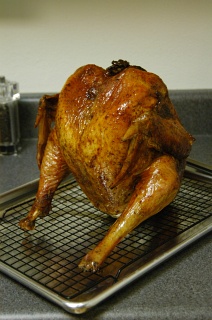 Remove the turkey from the grill and let sit for five minutes to let the juices redistribute (and the exterior to cool enough to touch).
Remove the turkey from the grill and let sit for five minutes to let the juices redistribute (and the exterior to cool enough to touch).Using folded paper towels or oven mitts (which you don't mind getting dirty), lift the turkey and pull out the beer can. Be careful because the beer can will still be hot and half full of hot liquid (beer and turkey drippings).
Carve (a pictorial is included in the Classic Roast Turkey article) and serve with your favorite accompaniments. The giblet pan gravy can be prepared using the beer from the can (after the oil has been removed) instead of the dry white wine from the gravy article.
This recipe tested pretty well. Parts of the drumsticks and the wings were a little dry (when compared to the oven roasted turkey) because they stick out while cooking. Even so, the turkey was complimented on its unexpected juiciness and full flavor.
Smoked Beer Can Turkey
Prepared Turkey
| turkey | brine | rub spice rub over skin, under skin, inside cavity |
| 2 Tbs. (28 g) brown sugar | combine | |
| 2 Tbs. (14 g) paprika | ||
| 1 Tbs. (15 g) kosher salt | ||
| 1 Tbs. (6.4 g) ground black pepper | ||
| 1 tsp. (1.8 g) cayenne pepper |
Prepared beer can
| 24 oz. beer can | remove top | pour beer and herbs in can |
| 6 bay leaves | crumble | |
| 2 tsp. (2 g) dried thyme | ||
| 12 ounces (355 mL) beer |
Smoked Beer Can Turkey
| Prepare grill for barbequeing with indirect heat | |||||
| 1 cup hickory wood chips | soak in water | place in metal container and onto grill | |||
| Prepared turkey | insert can into turkey | smoke until thigh meat reaches 160°F (71°C) | brush on glaze twice | smoke until thigh reaches 170°F (77°C) | |
| Prepared beer can | |||||
| 2 Tbs. (28 g) brown sugar | combine | ||||
| 2 Tbs. (30 g) ketchup | |||||
| 2 Tbs. (30 mL) distilled white vinegar | |||||
| 2 Tbs. (30 mL) beer | |||||
| 2 tsp. (10 mL) hot sauce | |||||
Related Articles

Plus, there are various chemical reactions that happen when you boil beer. I think of the beer can cooking method as a sort of cheap whiskey auto-basting.
I learned how to make this when I attended a Paul Prudhomme radio show back in the eighties. He has the receipe in one of his cookbooks.
The first time I cooked it, it took me three days and two bottles of bourbon. The bourbon is not part of the recipe. Now I buy deboned birds and it takes about a day.
Frank
Do you remember how much liquid was left in the can after the turkey had done it's smoking? Just curious because when I cook indirectly with a beer chicken, most if not nearly all of the liquid is left. When I do it pretty direct, a little is gone. Personally I think it's a nice way of holding the chicken upright.
My smoker ranges from 225F to maybe 250F, this is at grill level.
Biggles
It looked as if the beer level had not changed after cooking. Of course, there was a decent amount of fat and presumably juice from the turkey in the can as well - so it's hard to tell how much of the beer actually steamed.
re: flavor
I felt it was mostly the seasoning (herbs) and couldn't tell if any beer flavor actually was trasmitted to the turkey. For a real test, I'd have to prepare two turkeys (or more likely two small chickens with beer cans) - one with beer and one with water to see if there's a difference. Right now, I'm a little tired of eating poultry, so I need a bit of a break.
re: coke chicken
After I finished the turkey, Tina suggested that I try cooking a chicken with a glaze made of Coca-Cola. I know there's a Coca-Cola recipe book out there, but I don't have a copy. It sounds intriguing to me...
-- tom
Now, does beer steam impart flavor aromatically? I say yes. Here's a simple experiment that will disprove your theory: Pour a can of beer into a saucepan and put heat to it. As it comes up to a boil you'll notice the smell immediately. Within minutes your whole house will smell like a brewery.
Poultry is a more difficult meat to infuse, however, so there are a few things you can do to stack the can in your favor. My technique is based on Steve Raichlen's book Beer-Can Chicken: And 74 Other Offbeat Recipes for the Grill.
First of all, you must use a dark beer. The darker the beer, the richer the flavor. I like to cook with Yuengling Black And Tan. It is full flavored without costing as much as a boutique beer.
Secondly, substitute the brine water with more beer. With a turkey this is gonna take a lot of beer, but with an average sized chicken, I never wind up using more than three cans or so.
Lastly, it helps to plug the neck hole to trap, thus recirculating the steam. Obviously you don't want it airtight but I like to shove an onion wedge in there.
I have also tried cooking a chicken over Coke as well as ginger-ale. I preferred the ginger-ale (the book has a great recipe that involves fresh ginger with the ginger-ale). I always come back to beer, though. Nothing seems to compliment the flavor of chicken more.
However, I would like to take you to task for the "new batch of charcoal" thing. Allowing a batch of charcoal to ash out, then starting with a whole new batch of hot coals, is almost like cooking the bird twice. You get your initial flash of heat twice, and thus have to watch for over-done skin twice. Pain in the ass!
The real way to do it is to replenish 5-10% of the coal pile with fresh coals every 30 minutes. These cold coals will slowly turn into fuel just as the old ones are ashing out, giving us the closest thing to even heat a charcoaler can get.
Incidentally, I'm trying my largest bird ever -- 26 lbs -- and I have had to raise the roof of my 22" Weber to accomodate the monster. I did so with 10 feet of 14" high aluminum flashing, fashioned into a ring that fits just inside the grill. Hopefully this should prevent heat loss while keeping the turkey sufficiently far from the fire to prevent the drumsticks from getting overdone.
This may be why your thigh meat tested a bit dry. It should be the part of the turkey with the most moisture.
GET A BIG GREEN EGG OR A REASONABLE FACILSIMILE. THROW AWAY THE GRILL - YOU WILL NEVER USE IT AGAIN.
THE SMOKENATOR
Rann
sugrpuz@gmail.com
JM
And YES, I am an engineer, a chemist, and a member of Les Marmitons.
Try the turkey on a large can of cream ale for a treat...
Equal parts Coca Cola and Ketchup.
It's no substitute for homemade or KC Masterpiece, but it tastes pretty good.
THANKS
Czech beer information, history, ow to make beer at home etc. and another information about Czech, Prague, travel, real estate, prices, foto galery, Prague pubs, tips
You should never consume a turkey which has not achieved a smoked tempureture of 165...If said turkey is cooked to the required temp it will have a destinctive smoke ring and rather pink hue to the meat.
The beer will have a minuet flavor enhancement at best. perhaps engineering can find a more effective way to use beer,ingestion works well for Q.C.
It has been determined however that the BRINE is the decideding factor in flavor and should not be ignored.
There are many recipies and perhaps engineering can determine which offers one that can please the palate of the masses on a consistant basis.
Thanks for the debate,
Bill
~Susan
I never brined my turkeys and they came out perfect. I used a 24 ounce beer can and added my ingrdients in the beer after I took a drink or two. I use a light beer.
I use my trailer pit for these big birds and usually let them smoke for about 5-6 hours at about 200-250 degrees. I smoke them using mesquite. I [u:2b47ff440c]NEVER[/u:2b47ff440c] use lighter fluid or charcoal.
Not only do you get the flavor of the beer and the ingredients, but you also get the flavor of the mesquite. You can kill 3 birds with one stone.
When I do the beer can method, I rotate my bird every hour, I also check the beer levels. When I cook my bird I notice that the beer does evaporate and I have to fill the can back to the original level.
One thing that I do before I put my dry rub on the bird is rub a generous amount of vegetable oil or olive oil all over the turkey. This makes the skin come out nice and crisp with that golden color. Then add your rub.
The leftover beer and ingredients make a great sauce. I add the beer to a sauce pan and heat. I then add water to cornstarch and form a paste and add it to the sauce pan. Stir well and let sit to thicken. If to thick add water or more beer. If you have last minute questions you can reach me at the following site.
Keep up the great work!
Gabe
www.southtexasbarbecue.com
Great recipe.
http://en.wikipedia.org/wiki/Soda_can#Composition
Aluminium cans often contain an internal coating to protect the aluminium from beverage corrosion. Despite this coating, trace amounts of aluminium can be degraded into the liquid, the amount depending on factors such as storage temperature and liquid composition.[6][7] Chemical compounds used in the internal coating of the can include types of epoxy resin.[8]
The article shows a turkey, and a time of 4-4.5 hours, but doesn't say how large the bird was.
Thanks in advance.
Chris Hohenwald.
Well worth watching and good advice.
http://www.8legged.com/DeepFriedLive/DFL01_01.html
FYI I am cooking a chicken on my grill with a can of Pabst. I am drinking a Franziskaner....
;-)
mort
http://www.nakedwhiz.com/beercanchicken.htm
I used a 1 litre can of Asahi Super Dry as I am living in Japan.
I followed the rub recipe and placed a 12lb. bird over the opened can, inside a Reynolds Oven Bag, and rested it all in a roasting pan.
This went into a smoking grill and remained over the coals for about 3 hours.
Smoke was added and could be tasted in the meat, but not overpowering due to the bag.
However, the bag did help infuse the flavour of the beer and keep the whole bird moist from wing to tail.
I will definately use the same technique next time as the results were outstanding and received nothing but compliments.
Thanks for the posts.